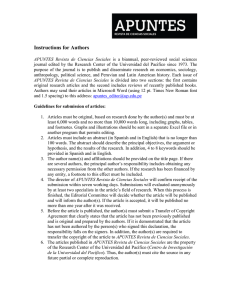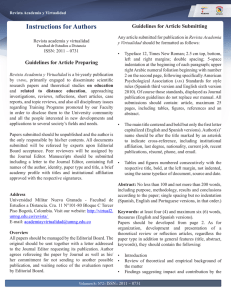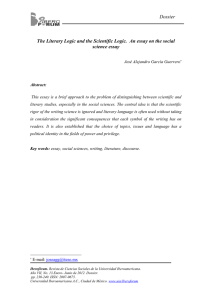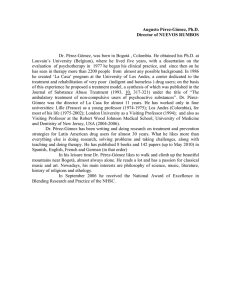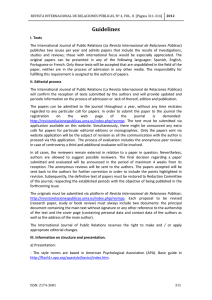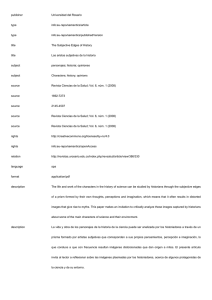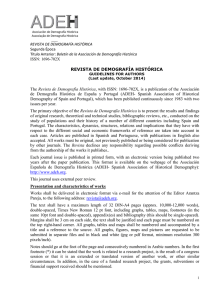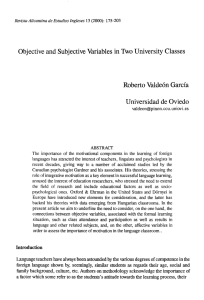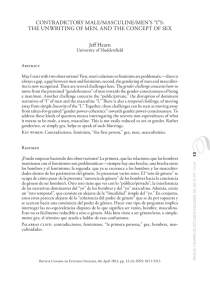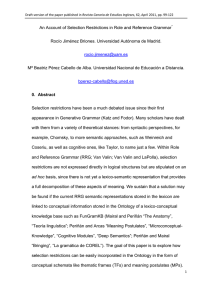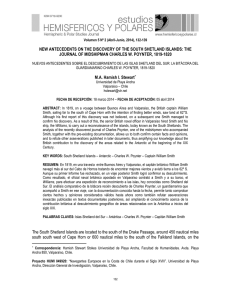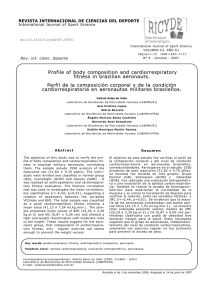Parameters for the Submission of Articles Type of articles
Anuncio
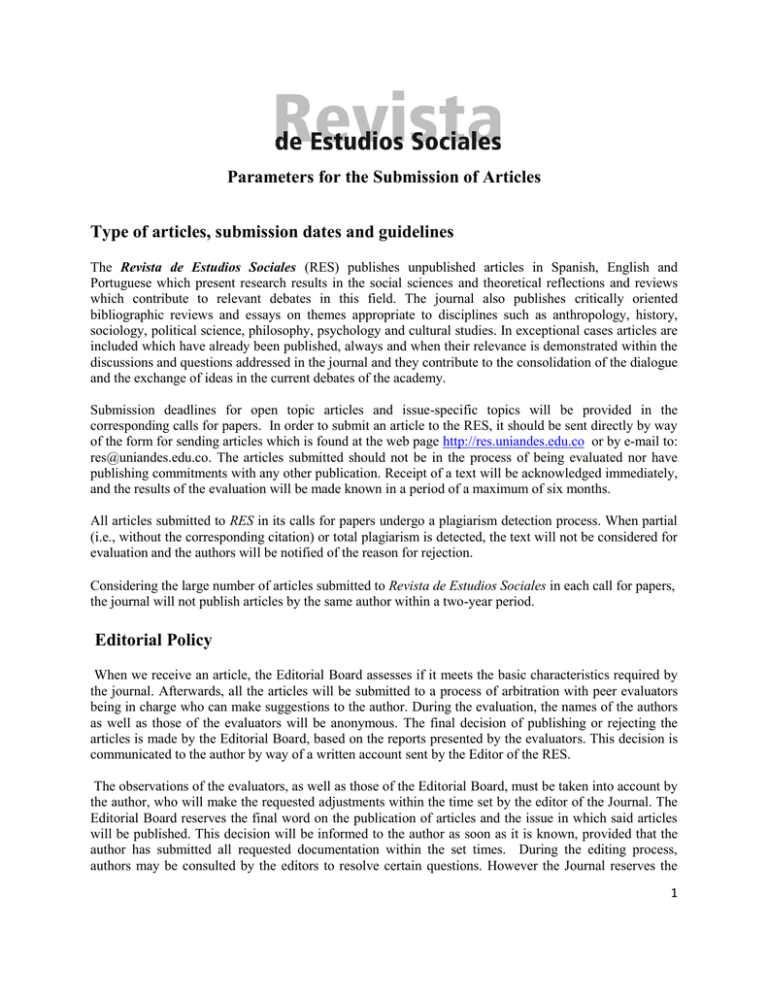
Parameters for the Submission of Articles Type of articles, submission dates and guidelines The Revista de Estudios Sociales (RES) publishes unpublished articles in Spanish, English and Portuguese which present research results in the social sciences and theoretical reflections and reviews which contribute to relevant debates in this field. The journal also publishes critically oriented bibliographic reviews and essays on themes appropriate to disciplines such as anthropology, history, sociology, political science, philosophy, psychology and cultural studies. In exceptional cases articles are included which have already been published, always and when their relevance is demonstrated within the discussions and questions addressed in the journal and they contribute to the consolidation of the dialogue and the exchange of ideas in the current debates of the academy. Submission deadlines for open topic articles and issue-specific topics will be provided in the corresponding calls for papers. In order to submit an article to the RES, it should be sent directly by way of the form for sending articles which is found at the web page http://res.uniandes.edu.co or by e-mail to: [email protected]. The articles submitted should not be in the process of being evaluated nor have publishing commitments with any other publication. Receipt of a text will be acknowledged immediately, and the results of the evaluation will be made known in a period of a maximum of six months. All articles submitted to RES in its calls for papers undergo a plagiarism detection process. When partial (i.e., without the corresponding citation) or total plagiarism is detected, the text will not be considered for evaluation and the authors will be notified of the reason for rejection. Considering the large number of articles submitted to Revista de Estudios Sociales in each call for papers, the journal will not publish articles by the same author within a two-year period. Editorial Policy When we receive an article, the Editorial Board assesses if it meets the basic characteristics required by the journal. Afterwards, all the articles will be submitted to a process of arbitration with peer evaluators being in charge who can make suggestions to the author. During the evaluation, the names of the authors as well as those of the evaluators will be anonymous. The final decision of publishing or rejecting the articles is made by the Editorial Board, based on the reports presented by the evaluators. This decision is communicated to the author by way of a written account sent by the Editor of the RES. The observations of the evaluators, as well as those of the Editorial Board, must be taken into account by the author, who will make the requested adjustments within the time set by the editor of the Journal. The Editorial Board reserves the final word on the publication of articles and the issue in which said articles will be published. This decision will be informed to the author as soon as it is known, provided that the author has submitted all requested documentation within the set times. During the editing process, authors may be consulted by the editors to resolve certain questions. However the Journal reserves the 1 right copy edit the text for minor errors. Both during the evaluation and editing processes, e-mail will be the most used means of communication with the author. Parameters for the Submission of Articles It is required that the articles sent comply with the established parameters for the magazine for their submission: - Be written in Word format, in Times New Roman font Size 12, Line spacing 1 ½, paginated, in lettersize paper and with margins of 2.5 cm. The footnotes should be in Times New Roman 10 and singlespaced. - Have a length of between 7.000 and 10.000 words, including summaries, key words and footnotes. - Have a summary of the article in Spanish, of no more than 120 words, and itscorresponding translation into English. The title of the text should be similarly presented in both languages. - Have between 3 and 6 key words which identify the article, in English as well as in Spanish. It is necessary that both groups be included in the form for sending articles. The key words should reflect the contents of the document and it is therefore necessary thatthey point out the precise themes of the article, covering the areas of knowledge in which they fall and the principle concepts. It is recommended that the terms and hierarchies in the bibliographical lists (THESAURUS) be reviewed and correspondence between titles, summaries and key words be sought. - Be written in language accessible to audiences from different disciplines. - Author information must be included in an additional document and must include name, address, phone number, e-mail, academic titles, institutional affiliation, current position, current studies, and publications in books and journals. -Said page must also indicate what investigation the article is a result of and how it was funded. Editing Rules - The first time an acronym or abbreviation is used it should go between parentheses after the complete expression. Subsequent times only the acronym or abbreviation will be used. - Quotations over four lines long must be placed in long form, single-spaced, in 11 point font and with reduced margins. - The “Revista de Estudios Sociales” uses and adaptation of the Chicago Manual of Style author-date style for presenting citations and references included in the article. The required punctuation details (comma, period, colon, parentheses, etc.) and the required information should be observed. The bibliographical list should include the references which have been cited in the text (in a 1 to 1 relationship), enumerated and in alphabetical order. It is essential that the complete names of the authors and/or editors be included in each one of the references. 2 Examples are presented below which show the differences between the form of citation within the text (T) and the form of citation in the bibliographical list (B). Book by a single author: T: (Abello 2003) B: Abello, Ignacio. 2003. Violencias y culturas. Bogotá: Universidad de los Andes – Alfaomega Colombiana. Book by two or three authors: T: (Drennan, Herrera and Uribe 1989, 27) B: Drennan, Robert, Luisa Fernanda Herrera and Carlos Alberto Uribe. 1989. Cacicazgos prehispánicos del Valle de la Plata. El contexto medioambiental de la ocupación humana. Tomo 1. Bogotá: Pittsburg University -Universidad de los Andes. Four or more authors: T: (Laumann et al. 1994) B: Laumann, Edward, John Gagnon, Robert Michael and Stuart Michaels. 1994. The Social Organization of Sexuality: Sexual Practices in the United States. Chicago: University of Chicago Press. Book chapter: T: (Saldarriaga 2004, 32-33) B: Saldarriaga, Lina Maria. 2004. Aprendizaje cooperativo. En Competencias ciudadanas: de los estándares al aula. Una propuesta integral para todas las áreas académicas, eds. Enrique Chaux, Juanita Lleras and Ana María Velásquez. Bogotá: Ministerio de Educación Nacional-Universidad de los Andes, 102-135. Magazine article: T: (Aguilar 2008) B: Aguilar, Sandra. 2008. Alimentado a la nación: género y nutrición en México (1940-1960). Revista de Estudios Sociales 12: 101-108. In the event that the journal has a volume and number, it will be cited in the following manner: Last Name, First Name, Title. Name of the journal volume, no. #: Pages. For example: Guttman, Allen. 2003. Sport, Politics and the Engaged Historian. Journal of Contemporary History 38, no. 3: 363-375. Documents downloaded from the internet: T: (Londoño 2005, 70) B: Londoño, Luz María. 2005. La corporalidad de las guerreras: una mirada sobre las mujeres combatientes desde el cuerpo y el lenguaje. Revista de Estudios Sociales 21: 67-74. < http://res.uniandes.edu.co> (Downloaded August 31, 2005). Press article: T: (Martin 2008) B: Martin, Steve. 2002. Sports-interview Shocker. New Yorker, May 6. T: (Arango 2008) B: Arango, Rodolfo. 2008. Oposición inmadura. El Espectador, August 6. Book review: T: (Duque 2008) B: Duque, Juliana. 2008. Review of the book Alimentación, género y pobreza en los Andes ecuatorianos, by Mary Weismantel. Revista de Estudios Sociales 29: 177-178. 3 Thesis or dissertation: T: (Amundin 1991, 22-29) B: Amundin, Mats. 1991. Click Repetition Rate Patterns in Communicative Sounds from the Harbour Porpoise, Phocoena phocoena. Doctoral dissertation, University of Stockholm. Presentations: T: (Doyle 2002) B: Doyle, Brian. 2002. Howling Like Dogs: Metaphorical Language in Psalm 59. Paper presented at the Annual International Meeting for the Society of Biblical Literature, Junio19-22, in Berlin, Germany. Note: In no case should Ibid, ibidem or op. cit. be used. - Articles which include source files should present the references in numbered footnotes, in such a way that will facilitate the reader’s identification and access to the documents in the corresponding file. It is necessary to indicate: Abbreviation of the file, Section, Source, vol./leg.’t., f. off. (place, date and other relevant information). The first time the complete name of the file is cited with abbreviation between parentheses and subsequently just the abbreviation. At the end of the text, all the primary references should be gathered in a list separate from the bibliography. - Tables, graphics and illustrations, should be presented on a separate page at the end of the text. Images must be submitted in high quality digital format. Obtaining the publication authorization of figures which require it is responsibility of the author. -It is necessary to indicate within the text the place where each table/graphic/illustration is located. This instruction is placed between parentheses, in the following manner: [Insert Table 1here] -A moderate use of tables, graphics and illustrations is recommended. Parameters for the Submission of Reviews - Be written in Word format, in Times New Roman 12, paginated and in letter-size paper. margins of 2.5 cm. -Have a length of between 2 and 6 pages (single-spaced). -Include complete information about the reviewed text (author, title, date, city, publisher and total pages). - Author information must be included in the same document: name, academic titles, institutional affiliation, current position, current studies, and e-mail. Directions for authors -Each author will receive 2 courtesy copies of the Revista de Estudios Sociales. -The authors and/or holders of the accepted articles authorize the use of author’srights (reproduction, public communication, transformation and distribution) to the Universidad de los 4 Andes/Social Sciences faculty, for the inclusion of their writing or article in the Revista de Estudios Sociales (print version and electronic version). -If the article is to be used afterwards in another publication, the original publication in Revista de Estudios Sociales must be clearly stated, and authorization must have been previously requested to the RES. 5
